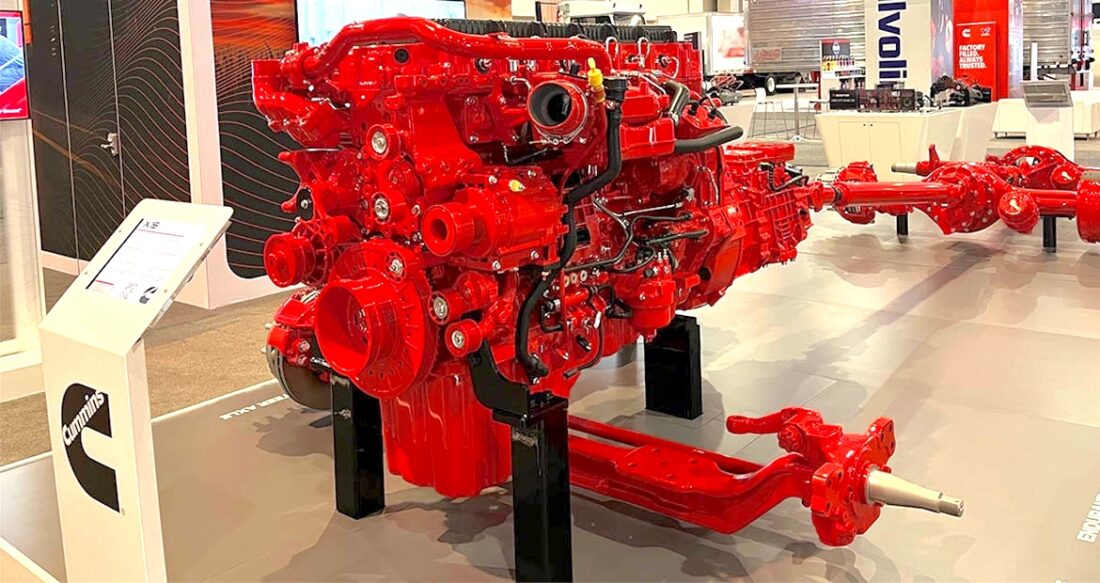Tariffs Muddy Cummins Financial Picture
- A 2027 Cummins X15N engine made at the Jamestown Engine Plant in Busti is pictured at the American Trucking Associations’ Technology & Maintenance Council Annual Meeting and Transportation Technology Exhibition in March in Nashville, Tenn.
- Jennifer Rumsey, Cummins Inc. chair and CEO, is pictured.

A 2027 Cummins X15N engine made at the Jamestown Engine Plant in Busti is pictured at the American Trucking Associations’ Technology & Maintenance Council Annual Meeting and Transportation Technology Exhibition in March in Nashville, Tenn.
President Donald Trump’s tariffs haven’t impacted Cummins Inc.’s bottom line yet.
Mark Smith, the company’s chief financial officer, said it’s possible that changes starting in the second quarter. One of the first changes the general public will see is the company’s decision not ot provide an outlook for revenue or profitability for the rest of the year.
“What I will say is, the impact of tariffs on our financial results in Q1 was immaterial,” Smith said during a conference call with investor analysts on Monday. “So those results that you saw, which were very strong, had essentially close to zero financial impact. So that’s going to change, right? It’s going to change and it’s going to change month-to-month certainly as we start to go through the second quarter, probably it’s contributing to the biggest degree of uncertainty for the second half of the year in terms of the demand outlook. There’s uncertainty now, but the visibility into the second half is, we will give the impacts of the tariffs as we go along in our financial results. Needless to say, I would say, it’s going to build over the next few months. There will be some lag inevitably between ordering, incurring, mitigating and recovering all of those costs.”
Despite a 3% decrease in revenues, Cummins’ earnings generally beat analysts expectations with the company’s stock trading higher in trading late Monday. Cummins officials said the company’s first quarter revenues of $8.2 billion decreased 3% from the same quarter in 2024. Revenues decreased 4% in North America and 11% in international markets due to lower on-highway demand in the United States and Latin America. Sales in North America decreased 1%, and international revenues decreased 5% due to lower demand in Latin America and Asia Pacific, partially offset by higher sales in China. Earnings before interest, taxes, depreciation and amortization (EBITDA) in the first quarter were $1.5 billion, or 17.9% of sales, compared to $2.6 billion, or 30.6% of sales, a year ago.
Engine segment sales, which would encompass the company’s Jamestown Engine Plant in Busti, recorded sales of $2.8 billion in the first quarter of 2025, a 5% decrease from the same period in 2024. Engine segment EBITDA was $458 million, or 16.5% of sales, compared to $414 million, or 14.1% of sales in 2024.

Jennifer Rumsey, Cummins Inc. chair and CEO, is pictured.
But the tariff news isn’t all bad, according to Jennifer Rumsey, Cummins chair and CEO. Trump’s aim is to boost U.S. manufacturing, which could help Cummins on one front while possibly hurting the company when it comes to its supply chain.
“As a large U.S. headquartered company with significant manufacturing in the U.S, we appreciate the administration’s support for American manufacturing,” Rumsey said. “This support is crucial as we invest more than $1 billion in our engine and power systems manufacturing operations in the U.S. over the next few years, employing people in nearly every state through our manufacturing plants and sales and service branches. As we evaluate our current manufacturing footprint and our exposure to tariff regulations, we believe we are well-positioned because we primarily produce engines and gensets in the markets where we sell them. For instance, our medium duty, heavy duty and high horsepower engines, as well as power generation products for U.S. customers, are manufactured in our plants located in Indiana, North Carolina, New York and Minnesota. However, like much of our industry, our component and supplier manufacturing would be affected by current tariff regulations, which could disrupt the global economy and ultimately lead to higher costs for consumers.”
Among first quarter highlights for Cummins are the launch of two new engines, the X10 as part of the Cummins HELM platforms replacing both the L9 and X12 engine platforms. Cummins also unveiled the new Cummins B7.2 diesel engine that brings the latest technology and advancements to one of our most proven platforms. The new engine will feature a slightly higher displacement and is designed to be a global platform which creates flexibility for different applications and duty cycles. Both the B7.2 and X10 engines will be manufactured at Rocky Mount Engine Plant in North Carolina and will go into production in North America in 2027.
“And I just want to remind you, as you look at overall really strong performance in Q1, even with softening in North America truck, we remain focused on the key areas we’ve been talking to you about, including in our last Analyst Day, even as we manage through uncertainty and tariffs and work to mitigate tariffs,” Rumsey said. “So improving gross margin in the business, we have a growing aftermarket population that allows that aftermarket market revenue to continue to grow over time, and we’re still investing in critical areas. We continue to invest in capacity expansion in the Power Systems business and these next-generation engine platforms, while also monitoring pace of decarbonization and regulation and pacing investment in other areas. And so, we continue to be focused on that even as we navigate through this uncertain time.”






